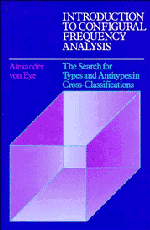 Introduction to Configural Frequency Analysis
Introduction to Configural Frequency Analysis from Part I - Concepts of configural frequency analysis
Published online by Cambridge University Press: 04 August 2010
In empirical sciences, many data are categorical, that is nominal or ordinal in nature. Examples of nominal variables, which are essentially qualitative, include membership in political parties, religion, sex, and presence or absence of illness. Examples of ordinal variables, which rank observational units according to the relative degree to which they possess a particular attribute, include grades in school, severity of illness, and psychometric scores as measures of cognitive complexity or creativity.
The states of categorical variables are mutually exclusive. Therefore, every individual can be assigned to only one state per variable at a time. When two or more categorical variables are measured they can be cross-classified so that every variable may be observed under every state of every other variable. When d variables are cross-classified, a d-dimensional contingency table results (with d ≥ 2).
Consider, for instance, the three variables extraversion (E), criminal behavior (C), and intelligence (I), with categories as follows: E1 = extravert, E2 = introvert, C1 = presence of criminal record, C2 = absence of criminal record, I1 = high intelligence, and I2 = low intelligence. These three variables can be crossed to form a three-dimensional contingency table that has 2 × 2 × 2 = 8 cells. Table 1.1 presents the eight elementary cells of the present example in tabular form, along with labels specifying the states of each variable.
To save this book to your Kindle, first ensure [email protected] is added to your Approved Personal Document E-mail List under your Personal Document Settings on the Manage Your Content and Devices page of your Amazon account. Then enter the ‘name’ part of your Kindle email address below. Find out more about saving to your Kindle.
Note you can select to save to either the @free.kindle.com or @kindle.com variations. ‘@free.kindle.com’ emails are free but can only be saved to your device when it is connected to wi-fi. ‘@kindle.com’ emails can be delivered even when you are not connected to wi-fi, but note that service fees apply.
Find out more about the Kindle Personal Document Service.
To save content items to your account, please confirm that you agree to abide by our usage policies. If this is the first time you use this feature, you will be asked to authorise Cambridge Core to connect with your account. Find out more about saving content to Dropbox.
To save content items to your account, please confirm that you agree to abide by our usage policies. If this is the first time you use this feature, you will be asked to authorise Cambridge Core to connect with your account. Find out more about saving content to Google Drive.